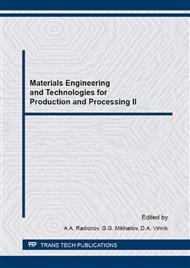[1]
M.K. Rocco, R.S. Williams, P. Alivisatos, Nanotechnology in the nearest decade: Prediction of a trend in investigations, transl., Mir, Moscow, 2002. (in Russian).
Google Scholar
[2]
V.M. Segal, The processes of metal treatment by intensive plastic deformation, Metally. 5 (2006) 130-141. (in Russian).
Google Scholar
[3]
V.V. Rybin, Large plastic deformations, Metallurgiya, Moscow, 1986. (in Russian).
Google Scholar
[4]
I.V. Gorynin, Ye.I. Khlustova, Nanostructured steels for the development of the Arctic Ocean shelf deposits, Vestnik RAN. 12 (2010) 1069-1075. (in Russian).
Google Scholar
[5]
T.M. Makheva, The Nature of instability of the level of impact strength and low processing plasticity at the production of large in-process goods from corrosion-resistant maraging steels, improvement of the technology for their processing, Ph.D. diss., Izhevsk, 2012. (in Russian).
Google Scholar
[6]
Ya.D. Kogan, Yu.A. Konovalov, Resource-saving technologies for steel nitriding in a confined space, MiTOM. 5 (1991) 2-4. (in Russian).
Google Scholar
[7]
V.S. Krylov, G.V. Shcherbedinskiy, Nitrogen solubility in alloy steels in the nitriding process at low pressure, Metally. 3 (1978) 193-195. (in Russian).
Google Scholar
[8]
Yu.M. Lakhtin, Ya.D. Kogan, S.M. Soshkin, Steel nitriding in vacuum, MiTOM. 9 (1980) 13-15. (in Russian).
Google Scholar
[9]
S.M. Soshkin, Yu.M. Lakhtin, Ya.D. Kogan, Structure of diffusion layer at vacuum nitriding, MiTOM. 7 (1984) 32-34. (in Russian).
Google Scholar
[10]
PCT Patent 93/10274. (1994).
Google Scholar
[11]
H. Burns, RU Patent 2127330. (1999).
Google Scholar
[12]
T.M. Makhneva, V.B. Dement'yev, N.V. Goncharova, Method for nitriding high-strength stainless steels with nanocrystalline structure, Izhevsk, Vestnik IZhGTU. 1 (2010) 26-29. (in Russian).
Google Scholar
[13]
T.M. Makhneva, N.V. Goncharova, G.V. Aleksandrova, The formation of nitrogen austenite in steel 08Cr15Ni5Cu2Ti at hardening in a confined space, MiTOM. 12 (2006) 24-27. (in Russian).
Google Scholar
[14]
N.V. Goncharova, T.M. Makhneva, E.P. Elsukov, E.V. Voronina, Phase transformations in chromium ferrite alloy at thermal treatment in a confined space in air medium, Perspektivnye materially. 4 (2000) 83-90. (in Russian).
Google Scholar
[15]
N.V. Goncharova, T.M. Makhneva, E.P. Elsukov, E.V. Voronina, Residual austenite in ferrite alloy Fe-Cr, FMM. 86 (1998) 53-58. (in Russian).
Google Scholar
[16]
Yu.M. Lakhtin, E.S. Tsyrlin, Z.F. Shustova, P.G. Lapin, Nitriding maraging steel EP699, Metallovedenie i termicheskaya obrabotka metallov. 6 (1972) 23-25. (in Russian).
DOI: 10.1007/bf00648300
Google Scholar
[17]
N.V. Goncharova, T.M. Makhneva, RU Patent 2184175. (2002). (in Russian).
Google Scholar
[18]
N.V. Goncharova, Modeling phase transformations in Fe-Cr alloys at high temperatures, Ph.D. diss., Izhevsk, 2000. (in Russian).
Google Scholar
[19]
N.V. Goncharova, T.M. Makhneva, Method for the investigation of phase transformations in alloy Fe-Cr in the high-temperature region, Zavodskaya laboratoriya: Diagnostika materialov. 71 (2005) 28-33. (in Russian).
Google Scholar
[20]
B.S. Bokshteyn, Diffusion in metals and alloys, Metallurgiya, Moscow, 1978. (in Russian).
Google Scholar
[21]
A.N. Morozov, Hydrogen and nitrogen in steel, Metallurgiya, Moscow, 1968. (in Russian).
Google Scholar
[22]
W. Murray Small, Nitrogen solubility in solid Fe-Cr-Ni alloys, Scripta Metallurgica et materialia. 24 (1990) 1695-1696.
DOI: 10.1016/0956-716x(90)90530-t
Google Scholar
[23]
S.M. Stevens, Nitrogen in Iron and Steel, Weld. Res. Counc. Bull. 369 (1992) 3-38.
Google Scholar


